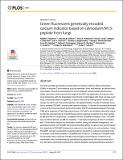Green fluorescent genetically encoded calcium indicator based on calmodulin/M13-peptide from fungi
Author(s)
Barykina, Natalia V.; Subach, Oksana M.; Malyshev, Aleksey Y.; Smirnov, Ivan V.; Bogorodskiy, Andrey O.; Borshchevskiy, Valentin I.; Varizhuk, Anna M.; Pozmogova, Galina E.; Anokhin, Konstantin V.; Enikolopov, Grigori N.; Subach, Fedor V.; Piatkevich, Kiryl; Jung, Erica E.; Boyden, Edward; ... Show more Show less
Downloadjournal.pone.0183757.pdf (14.35Mb)
PUBLISHER_CC
Publisher with Creative Commons License
Creative Commons Attribution
Terms of use
Metadata
Show full item recordAbstract
This is an open access article distributed under the terms of the Creative Commons Attribution License, which permits unrestricted use, distribution, and reproduction in any medium, provided the original author and source are credited. Currently available genetically encoded calcium indicators (GECIs) utilize calmodulins (CaMs) or troponin C from metazoa such as mammals, birds, and teleosts, as calcium-binding domains. The amino acid sequences of the metazoan calcium-binding domains are highly conserved, which may limit the range of the GECI key parameters and cause undesired interactions with the intracellular environment in mammalian cells. Here we have used fungi, evolutionary distinct organisms, to derive CaM and its binding partner domains and design new GECI with improved properties. We applied iterative rounds of molecular evolution to develop FGCaMP, a novel green calcium indicator. It includes the circularly permuted version of the enhanced green fluorescent protein (EGFP) sandwiched between the fungal CaM and a fragment of CaM-dependent kinase. FGCaMP is an excitation-ratiometric indicator that has a positive and an inverted fluorescence response to calcium ions when excited at 488 and 405 nm, respectively. Compared with the GCaMP6s indicator in vitro, FGCaMP has a similar brightness at 488 nm excitation, 7-fold higher brightness at 405 nm excitation, and 1.3-fold faster calcium ion dissociation kinetics. Using site-directed mutagenesis, we generated variants of FGCaMP with improved binding affinity to calcium ions and increased the magnitude of FGCaMP fluorescence response to low calcium ion concentrations. Using FGCaMP, we have successfully visualized calcium transients in cultured mammalian cells. In contrast to the limited mobility of GCaMP6s and G-GECO1.2 indicators, FGCaMP exhibits practically 100% molecular mobility at physiological concentrations of calcium ion in mammalian cells, as determined by photobleaching experiments with fluorescence recovery. We have successfully monitored the calcium dynamics during spontaneous activity of neuronal cultures using FGCaMP and utilized whole-cell patch clamp recordings to further characterize its behavior in neurons. Finally, we used FGCaMP in vivo to perform structural and functional imaging of zebrafish using wide-field, confocal, and light-sheet microscopy.
Date issued
2017-08Department
Massachusetts Institute of Technology. Media Laboratory; McGovern Institute for Brain Research at MITJournal
PLOS ONE
Publisher
Public Library of Science
Citation
Barykina, Natalia V. et al. “Green Fluorescent Genetically Encoded Calcium Indicator Based on calmodulin/M13-Peptide from Fungi.” Edited by Eugene A. Permyakov. PLOS ONE 12, 8 (August 2017): e0183757 © 2017 Barykina et al.
Version: Final published version
ISSN
1932-6203